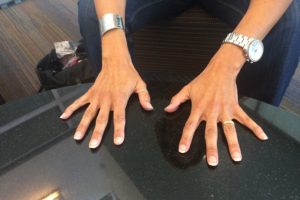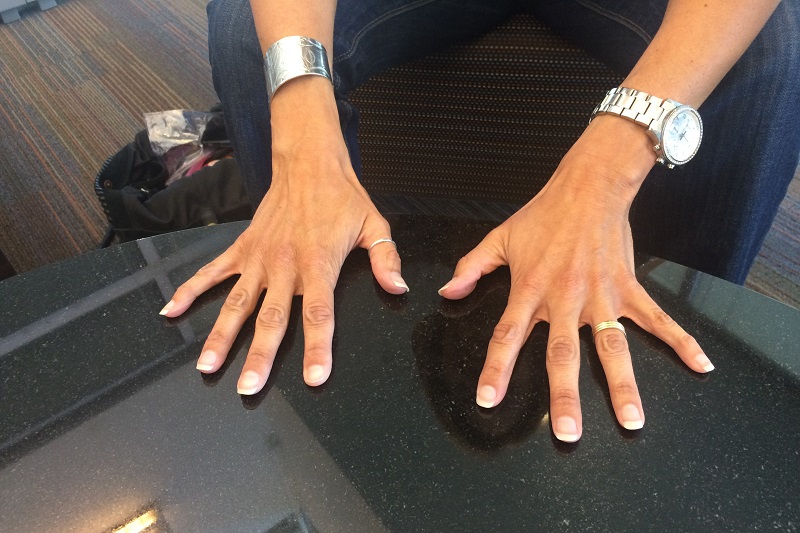 Amy Mack puts down her right hand and spreads out her fingers. “Each of these fingers represents an organization working for kids.” She turns her palm over and curls her fingers to form a fist. “And they must work with each other, leveraging each other strengths, to be effective and make a difference. It’s about interdependence; the impact is far less powerful if you work in isolation.” The executive director of Year Up Puget Sound, an organization that works to bridge the opportunity divide, often uses the hand analogy to explain and emphasize the concept of wraparound services working together successfully to help kids have a better future and change the systems that impede their progress.
Amy Mack puts down her right hand and spreads out her fingers. “Each of these fingers represents an organization working for kids.” She turns her palm over and curls her fingers to form a fist. “And they must work with each other, leveraging each other strengths, to be effective and make a difference. It’s about interdependence; the impact is far less powerful if you work in isolation.” The executive director of Year Up Puget Sound, an organization that works to bridge the opportunity divide, often uses the hand analogy to explain and emphasize the concept of wraparound services working together successfully to help kids have a better future and change the systems that impede their progress.
Amy, herself, is no stranger to the concept of collective impact. She has seen how collective impact works from three different perspectives: as an implementer, a funder, and an agent. In the early 90’s she worked in the mayor’s office in Indianapolis and collaborated with police officers, businesses, school districts, churches, and other community organizations to bring down high crime rates and make neighborhoods safer. “We identified which services each organization could provide in order to have the greatest impact.”
With a firm understanding of “boots on the ground” work, she moved from Indianapolis to serve as Chief of Staff at the Corporation of National Community Service in Washington, DC, the independent federal agency that oversees AmeriCorps programming and provides both volunteer and financial capacity for nonprofits across the country.
After moving to North Carolina in 2009, Amy became the President and CEO of Big Brothers Big Sisters Services Inc. (BBBS) where she became an agent of collective impact. The economy was badly hit and that also affected the funding for nonprofit organizations. “It was a turning point for nonprofits everywhere. We had to become very intentional about what we did and didn’t do well because we couldn’t continue doing everything.” Amy started engaging differently. She began conversations with organizations who could fill the service gaps that BBBS could no longer provide but were crucial to the needs of a child and a family. She created partnerships with organizations who could provide those services, better leveraging the community’s support.
When Amy moved to the Seattle area, she was naturally drawn to Eastside Pathways as an organization engaged in collective impact. She is a firm believer in the model and the needs it fills, so much so that she has taken it with her wherever she goes. According to Amy, Eastside Pathways helps organizations see each other not as competitors but as partners, working toward a common goal. She appreciates the benefit of what the partnership brings to the table: “We realized there are resources right here in the Puget Sound area that our students can access to achieve long-term success. Now we are leveraging each other’s strengths.”
 Year Up, which has been in the Seattle area since 2011 is nationally a 15-year-old organization that was started in Boston by Gerald Chertavian who wanted to help break down some of the barriers that could hinder success post high school graduation. “He believed that the zip code should not determine opportunity,” says Amy. “He wanted to give kids a hand up not a handout – teaching young people how to work for their success.” They have a well-honed model that, every year, provides opportunity for more than 300 students to learn both professional and technical skills and earn the opportunity for an internship. “Most of the students are first generation learners. Success typically requires more than a high school diploma or GED. We offer the opportunity for them to receive training and earn a quality internship, preparing them for a job and a career,” says Amy.
Year Up, which has been in the Seattle area since 2011 is nationally a 15-year-old organization that was started in Boston by Gerald Chertavian who wanted to help break down some of the barriers that could hinder success post high school graduation. “He believed that the zip code should not determine opportunity,” says Amy. “He wanted to give kids a hand up not a handout – teaching young people how to work for their success.” They have a well-honed model that, every year, provides opportunity for more than 300 students to learn both professional and technical skills and earn the opportunity for an internship. “Most of the students are first generation learners. Success typically requires more than a high school diploma or GED. We offer the opportunity for them to receive training and earn a quality internship, preparing them for a job and a career,” says Amy.
Year Up builds partnerships with companies around the Puget Sound. These companies engage the students in internships providing companies with a diverse pipeline of professionals. “At Year Up our students learn technical hard skills AND professional or soft skills preparing them to be confident in the corporate environment.”
According to Amy, one of the most important services provided by Eastside Pathways is the collection and presentation of data provided to partners. “The data provided by Eastside Pathways is significant to our work. It provides an understanding of the environment which as a leader helps me to make informed decisions for my organization and it provides a more complete understanding of how the work we are doing together is impacting our community.”
As chairperson of the Eastside Pathways Partner Leadership Committee (PLC), Amy values the various services provided by our partners. By design, the PLC works across organizations using their diverse strengths and skills to shape systems that support every child, step by step, from cradle to career. Looking toward 2017, Amy and the committee hopes to see more organizations join Eastside Pathways, understand the needs of the community and support one another in the work they do to create a better and sustainable community.
In addition, Amy supports the work of Eastside Pathways in informing businesses to understand and accept the disparities that exist in Bellevue in order to encourage working together to address those issues. “It’s a struggle, but we need to show the business community the pain points, how they can participate, and get them more involved.”
Amy embraces the role of Eastside Pathways as a convener of organizations to shine a light on the possibilities and opportunities to change systems that hinder the opportunity for success for all young people. “Eastside Pathways provides a blueprint of the complete ecosystem – showing how each piece is interconnected and that the whole system working together can have long-term positive impact.”
Article written by Sujata Agrawal, communications strategist and storyteller, and volunteer writer for Eastside Pathways

